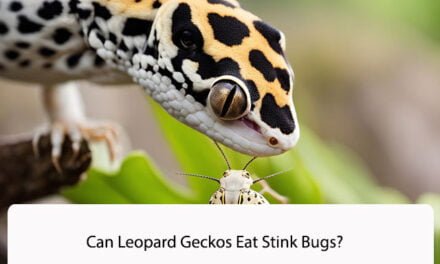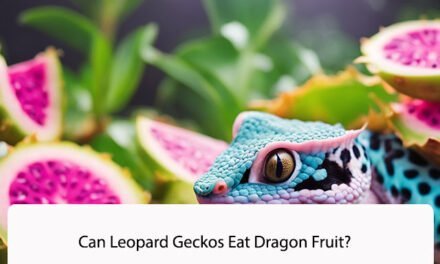Leopard geckos are fascinating pets that are easy to care for and have a diverse diet. As a result, many pet owners wonder if they can feed their leopard geckos silkworms. Silkworms are a popular feeder insect for many reptiles, but are they safe for leopard geckos to eat? In this article, we will explore the question, “Can leopard geckos eat silkworms?” and provide you with all the information you need to make an informed decision about your pet’s diet.
Leopard geckos are insectivores, which means they require a diet primarily consisting of insects. They are known to eat a variety of insects, including crickets, mealworms, and waxworms. Silkworms are also a popular feeder insect, but they are not commonly fed to leopard geckos. While leopard geckos can eat silkworms, it is important to understand the nutritional value and potential risks associated with feeding them to your pet. In the following paragraphs, we will discuss the nutritional value of silkworms and the potential risks associated with feeding them to leopard geckos.
Dietary Needs of Leopard Geckos

As responsible pet owners, it is important to understand the dietary needs of our leopard geckos. Providing them with a well-balanced diet is crucial to their overall health and wellbeing.
Leopard geckos are insectivores and their diet should consist primarily of insects. Some of the insects that are suitable for leopard geckos include crickets, mealworms, waxworms, and silkworms.
In addition to insects, leopard geckos also require a source of calcium. This can be provided through supplements or by feeding them insects that have been dusted with calcium powder.
It is important to note that leopard geckos should not be fed insects that are too large for them to consume. This can lead to impaction, a potentially life-threatening condition where the digestive tract becomes blocked.
Overall, providing a varied and balanced diet is essential for the health and wellbeing of leopard geckos. By understanding their dietary needs and providing them with appropriate food, we can ensure that they live long and healthy lives.
Benefits of Silkworms in a Gecko’s Diet
Silkworms are a nutritious addition to a leopard gecko’s diet. They are a great source of protein, calcium, and other essential nutrients that help maintain a healthy body. Here are some benefits of feeding silkworms to your gecko:
- High Protein Content: Silkworms are packed with protein, which is essential for the growth and development of your gecko. They contain all the essential amino acids that your gecko needs to build and repair its muscles, tissues, and organs.
- Low Fat Content: Silkworms have a low-fat content, which makes them an excellent choice for geckos that are prone to obesity. Feeding your gecko a diet that is high in fat can lead to health problems, such as fatty liver disease and heart disease.
- High Calcium Content: Silkworms are also a great source of calcium, which is essential for the development of strong bones and teeth. Calcium deficiency can lead to metabolic bone disease, which can cause deformities, fractures, and other health problems.
- Easy to Digest: Silkworms are easy to digest, which makes them a great choice for geckos that have digestive issues. They have a soft exoskeleton that is easy to break down, and they are also low in chitin, which is a tough, indigestible material that can cause digestive problems.
In conclusion, silkworms are a nutritious and healthy addition to a leopard gecko’s diet. They are packed with protein, low in fat, high in calcium, and easy to digest, making them an excellent choice for geckos of all ages and sizes.
Feeding Silkworms to Leopard Geckos

Silkworms are a great source of nutrition for leopard geckos. They are high in protein, low in fat, and easy to digest. Here are some important things to keep in mind when feeding silkworms to your leopard gecko.
Preparation of Silkworms
Before feeding silkworms to your leopard gecko, it’s important to prepare them properly. Silkworms should be gut-loaded with nutritious food for at least 24 hours before feeding them to your gecko. This ensures that your gecko receives the maximum nutritional benefit from the silkworms.
Silkworms should also be dusted with calcium and vitamin D3 supplements before feeding them to your leopard gecko. This helps to prevent calcium deficiency and other health problems.
Frequency of Feeding
Silkworms can be fed to leopard geckos as a regular part of their diet. However, it’s important to balance their diet with other sources of nutrition, such as crickets, mealworms, and other insects.
Adult leopard geckos can be fed silkworms once or twice a week, while younger geckos may need to be fed more frequently. It’s important to monitor your gecko’s weight and adjust their diet accordingly.
Portion Control
When feeding silkworms to your leopard gecko, it’s important to control the portion size. Overfeeding can lead to obesity and other health problems.
As a general rule, the portion size should be no larger than the size of your gecko’s head. This ensures that your gecko can easily digest the silkworms and prevents overfeeding.
In summary, feeding silkworms to your leopard gecko can be a great addition to their diet. By following these guidelines for preparation, frequency, and portion control, you can ensure that your gecko receives the maximum nutritional benefit from these nutritious insects.
Nutritional Value of Silkworms

Silkworms are a great source of nutrition for leopard geckos. They are rich in protein, calcium, and other essential nutrients that are important for the health and well-being of your pet.
Here are some of the key nutritional benefits of silkworms:
- Protein: Silkworms are an excellent source of protein, which is essential for the growth and development of leopard geckos. Protein helps to build and repair tissues, and it also plays a key role in the immune system.
- Calcium: Calcium is important for maintaining strong bones and teeth in leopard geckos. Silkworms are a good source of calcium, which helps to prevent bone disorders and other health problems.
- Fat: Silkworms are relatively low in fat compared to other feeder insects, which makes them a good choice for leopard geckos that are prone to obesity.
- Vitamins and minerals: Silkworms are also rich in vitamins and minerals, including vitamin B12, iron, magnesium, and potassium.
Overall, silkworms are a nutritious and healthy food choice for leopard geckos. They provide a good balance of protein, calcium, and other essential nutrients that are important for your pet’s health and well-being.
Potential Risks and Considerations
When feeding leopard geckos silkworms, there are a few potential risks and considerations that should be taken into account to ensure the health and safety of your pet.
Allergies and Sensitivities
As with any new food item, it is important to introduce silkworms to your leopard gecko gradually. Some geckos may have allergies or sensitivities to certain foods, which can lead to digestive upset or other health issues. If you notice any signs of discomfort or illness after introducing silkworms to your gecko’s diet, it is best to discontinue feeding them and consult with a veterinarian.
Pesticides and Parasites
Silkworms are often raised commercially and may be treated with pesticides or other chemicals. It is important to source silkworms from a reputable supplier and to wash them thoroughly before feeding them to your gecko. Additionally, silkworms can carry parasites such as mites, which can be harmful to your gecko’s health. Regular health checks and parasite prevention measures are recommended.
Calcium to Phosphorus Ratio
Leopard geckos require a diet that is high in calcium and low in phosphorus to maintain healthy bones and prevent metabolic bone disease. Silkworms have a relatively low calcium content and a high phosphorus content, which can disrupt this balance. It is important to supplement your gecko’s diet with calcium and vitamin D3, and to feed silkworms in moderation as part of a balanced diet.
In summary, while silkworms can be a nutritious addition to your leopard gecko’s diet, it is important to consider potential risks and take measures to ensure their safety and health. Gradual introduction, careful sourcing and preparation, and attention to calcium and phosphorus balance can help to minimize these risks.
Alternative Food Sources for Leopard Geckos

As leopard geckos are insectivores, they require a diet that is high in protein and low in fat. While crickets and mealworms are the most commonly used food sources for leopard geckos, there are other options that can be included in their diet.
- Silkworms: Silkworms are a great alternative to crickets and mealworms as they are low in fat and high in protein. They also have a soft exoskeleton which makes them easy to digest for leopard geckos. However, they are more expensive than crickets and mealworms and may not be readily available in all areas.
- Dubia Roaches: Dubia roaches are another great alternative to crickets and mealworms. They are high in protein and low in fat, and they are also easy to digest. They are also less noisy than crickets, making them a good option for those who are bothered by the chirping of crickets.
- Waxworms: Waxworms are a high-fat food source that should be fed sparingly. However, they can be a good treat for leopard geckos as they are soft and easy to digest. They should not be used as a staple food source.
- Superworms: Superworms are a good alternative to mealworms as they are higher in protein and lower in fat. However, they are also larger and harder to digest, so they should be fed sparingly.
It’s important to remember that a leopard gecko’s diet should be varied to ensure they are receiving all the nutrients they need. It’s also important to gut-load and dust their food with calcium and vitamin supplements to ensure they are getting the necessary nutrients.
Observing Your Gecko’s Health and Eating Habits
As responsible pet owners, it is important for us to monitor our leopard geckos’ health and eating habits. This helps us ensure they are getting the proper nutrition and care they need to thrive. Here are some tips on what to look out for:
Physical Appearance
Regularly checking your gecko’s physical appearance is crucial. A healthy gecko should have clear eyes, a plump tail, and smooth skin. If you notice any changes such as sunken eyes, weight loss, or rough skin, it may indicate a health issue.
Eating Habits
Leopard geckos are known for their hearty appetite, but it’s important to make sure they are eating a balanced diet. Offer a variety of food options, including silkworms, crickets, and mealworms. Keep track of how much and how often they are eating. If you notice a decrease in appetite or weight loss, it may be a sign of illness.
Table of Feeding Schedule
To ensure your gecko is getting the proper amount of food, it may be helpful to create a feeding schedule. Here is an example of a feeding schedule for a juvenile leopard gecko:
| Day | Morning | Afternoon | Evening |
|---|---|---|---|
| Monday | 2-3 small crickets | – | 2-3 small crickets |
| Tuesday | 2-3 small mealworms | – | 2-3 small mealworms |
| Wednesday | 2-3 small silkworms | – | 2-3 small silkworms |
| Thursday | 2-3 small crickets | – | 2-3 small crickets |
| Friday | 2-3 small mealworms | – | 2-3 small mealworms |
| Saturday | 2-3 small silkworms | – | 2-3 small silkworms |
| Sunday | – | – | – |
It’s important to note that this is just an example and feeding schedules may vary depending on your gecko’s age, size, and individual needs.
By observing your gecko’s health and eating habits, you can ensure they are getting the proper care they need to live a healthy and happy life.
Frequently Asked Questions

What are the benefits of feeding silkworms to leopard geckos?
Silkworms are a great source of protein and calcium for leopard geckos. They are also low in fat and high in moisture, making them a healthy addition to a leopard gecko’s diet.
How frequently should leopard geckos be fed silkworms?
Leopard geckos can be fed silkworms as a treat once or twice a week. It’s important to remember that silkworms should not be the only food in a leopard gecko’s diet. A varied diet is key to keeping your leopard gecko healthy.
Are there any risks associated with leopard geckos eating silkworms?
Silkworms are generally safe for leopard geckos to eat. However, it’s important to make sure that the silkworms are gut-loaded with nutritious food before feeding them to your gecko. Also, be sure to remove any uneaten silkworms from the enclosure to prevent them from crawling on your gecko and causing harm.
What is the appropriate serving size of silkworms for a leopard gecko?
The appropriate serving size of silkworms for a leopard gecko depends on the size and age of the gecko. As a general rule, a serving size of 2-3 silkworms per feeding is sufficient for an adult leopard gecko. Juvenile geckos may require smaller portions.
Can silkworms be a staple in a leopard gecko’s diet or should they be a treat?
Silkworms should be fed as a treat and not as a staple in a leopard gecko’s diet. While they are a healthy addition to a varied diet, they do not provide all of the necessary nutrients that a leopard gecko needs.
What other worms can be safely included in a leopard gecko’s diet?
Leopard geckos can also be fed mealworms, superworms, and waxworms in addition to silkworms. It’s important to make sure that these worms are gut-loaded and dusted with calcium powder before feeding them to your gecko.





